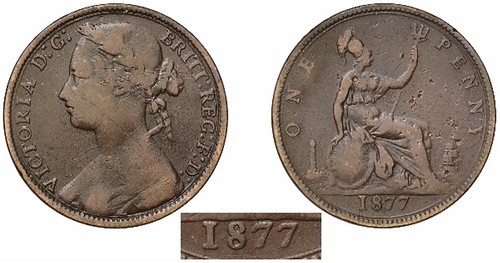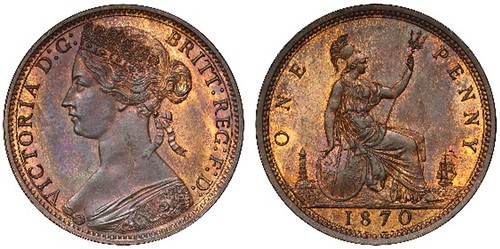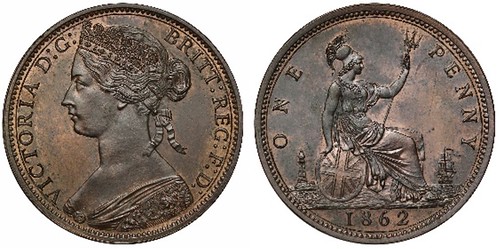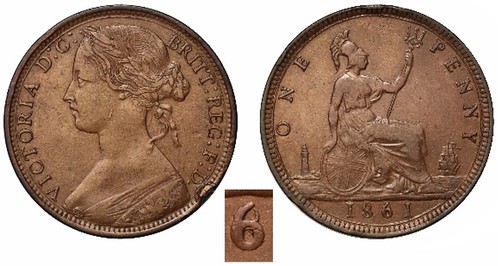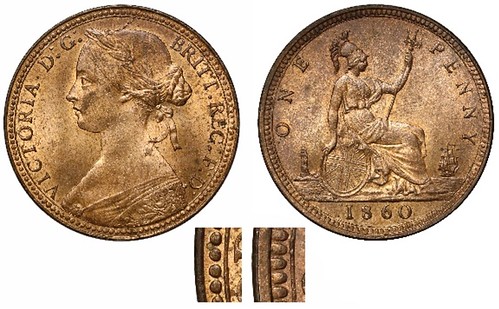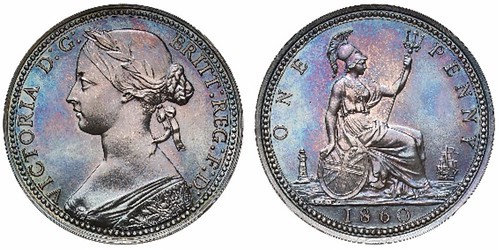
PREV ARTICLE
NEXT ARTICLE
FULL ISSUE
PREV FULL ISSUE
SOVEREIGN RARITIES WORKMAN COLLECTION, PART 3Sovereign Rarities of London UK are proud to present for auction on the afternoon of November 19th 2024 the Bernard Workman Collection of Bronze Penny Rarities 1860-1967 – a scintillating selection of forty of the most elusive pennies from the reigns of Queen Victoria to Queen Elizabeth II, including the extremely rare – one of two known – 1922 Specimen strike Penny with a Satin finish featuring a 1927 onward style reverse. -Garrett 
George V (1910-36) Bronze Satin Finish Specimen Penny 1922 with later 1927 onward style reverse NGC SP64BN Satin £6,000-£8,000 In last week's E-Sylum we showcased the finest currency Penny of 1922 with the later reverse, this week we exhibit the Satin Finish specimen coin which has some subtle differences to the reverse from the currency version. The main difference being with the distance between the upward flourish at the rear of Britannia's helmet and the plume beyond as well as other sharpened differences. The Satin finish patterns were completely unknown to UK collectors until the 1990s when the two only known examples turned up together as an obverse and reverse from a Specimen set with satin finishes supplied to the South Africa Mint Museum back in 1924. The colonial mint commenced work in Pretoria in 1923 with an extremely rare issue of currency Sovereigns and became more established by 1924. Seemingly two Specimen sets of coins were ordered from the Royal Mint London though a record does not survive, and the coins subsequently displayed in Pretoria. The coins ranging from a Halfcrown, Florin, Shilling, Sixpence, Threepence, Penny, Halfpenny and Farthing all have satin finishes and all dated 1924 except the Penny. The Threepence being of especial interest as there were no British currency threepence issued for this date, only as maundy money. The Penny could not be dated 1924 as there were no 1924 Pennies made that year. The nearest date to supply was 1922 and it was coupled with this later style reverse which was adopted to currency properly from 1927 onwards and for this satin finish Penny slightly different to the few currency versions of the 1922 Penny with 1927 reverse. It would seem the satin finish piece therefore came before what would become the adopted reverse from 1927 onwards due to the subtle differentiation explained above. The other example of the satin finish specimen is in a privately held complete set still, the coin offered here being from the set that was broken up for individual sale. The complete set was auctioned by Heritage in New York in 2004, the individual satin finish specimen Penny we have here has never been auctioned individually and slabbed as NGC SP64 brown satin with a £6,000-£8,000 estimate it will be interesting to see what results on 19th November 2024. One of the classic rarities of the 1870s of which very few survive to this day is the narrow date format Penny of 1877. Much more common is the usual currency wide date piece. Believe it or not this narrow date example is one of the better survivors though it did not receive a straight grade from NGC as it is damaged by multiple scratches, the date is clear and it is estimated to sell for £3,000-£4,000 on November 19th. We feature herewith one of the five bronze Patterns in the Bernard Workman Collection with the coronet head obverse by T. J. Minton after the model by sculptor W. Theed who was a designer for Wedgewood. Though this obverse design was never adopted for British currency similar styled pieces did appear for Malta, British Honduras and the Strait Settlements. Minton became Resident Engraver at the Mint from 1865 until he died when the post was made defunct. This bronze Pattern is dated 1870 and is graded as PF64 red and brown on an estimation of £5,000-£7,000 Following on from the previous two E-Sylum articles, this week we feature the last die number of the three different ones in the Bernard Workman collection. The small die number below the 8 and 6 of the date was a way of marking the Penny and its progress form manufacture in the dies from a relevant operator to its eventual release into circulation. Only four different die numbers are known and the collection contains numbers 2, 3 and 4 with two examples of number 3. All the survivors are in circulated condition and this number 2 example has not been straight graded but is nevertheless a British VF grade overall estimated at £5,000-£7,000 for November 19th. Above we have seen the 1870 Bronze Pattern Penny, well here is the 1862 version, again by Minton produced in the year the previous Resident Engraver George Wyon passed away. Though Minton did not officially become Resident Engraver until 1865. These wonderful renditions of the Queen with a coronet in her hair were never adopted for British coins but versions of it appeared on some colonial pieces as mentioned above. This 1862 dated example is graded PF64 brown and estimated at £2,000-£3,000. The third and final overdate in the Bernard Workman collection following on from those featured over the last two weeks is this 1861 where the 6 is struck over an 8. Highly unusual there are scant few survivors and this coin does exhibit some rim damage so has not straight graded. It is estimated conservatively at £600-800 for November 19th.
Victoria (1837-1901) Bronze Penny 1861 Freeman 27, dies 5+F R19 £500-£700
An unusual die combination for 1861 and extremely rare is this Penny with the no engraver signature obverse but yet retaining the recess in the truncation for it with fifteen leaf laurel wreath with double incuse veins. The reverse has a lighthouse with three horizontal lines depicting the junction between bricks and lantern, and there is also a thicker helmet plume for Britannia. A rock now touches the lower left of the shield as well as there being no designer initials. This is Freeman number 27 obverse die 5 combined with reverse F which is rated as R19 out of 20. The coin has not straight graded but estimated to sell for £500-£700. Two E-Sylum editions ago we talked about the muling together of dies that were not supposed to have been mated for coin production and featured an 1860 Penny with obverse toothed border rim and a reverse with beaded border rim, of which there are two in the Bernard Workman collection. This coin exhibits the muling the other way around with the beaded rim obverse die mated with the toothed rim reverse. This coin has the amazing grade of MS64 red and brown which must be the finest and estimated at £3,000-£4,000 for November 19th. Finally this week we feature the only Silver Proof Penny in the group of forty in the Bernard Workman Collection. This coin dates to the start of the bronze Penny series in 1860 derived from the first pairing of die design with the beaded borders. This coin is also struck on a thicker flan than usual as a silver Proof and is 2.35mm thick weighing just over 15 grammes. The coin has some nice rainbow colouring but has been lightly tooled across the reverse fields which is somewhat masked by the toning, therefore it has not been third party graded. The coin has an excellent provenance having been in the Palace Collections of Egypt sale of King Farouk's collection in 1954 whereupon it passed to the Philip G Smith collection where it was at the time of writing of Peck's British Museum Catalogue of 1958 and was later sold to Michael Freeman in 1967 and appears in his auction sale of 1984. Bernard Workman acquired it at a London auction in 2008 and this coin is believed to be one of six examples that exist. Estimated at £8,000-£10,000 there has been no example of the 1860 Silver Proof available publicly for sale since Bernard Workman bought this coin 16 years ago.
To read the earlier E-Sylum articles, see:
Wayne Homren, Editor The Numismatic Bibliomania Society is a non-profit organization promoting numismatic literature. See our web site at coinbooks.org. To submit items for publication in The E-Sylum, write to the Editor at this address: whomren@gmail.com To subscribe go to: https://my.binhost.com/lists/listinfo/esylum All Rights Reserved. NBS Home Page Contact the NBS webmaster 
|
